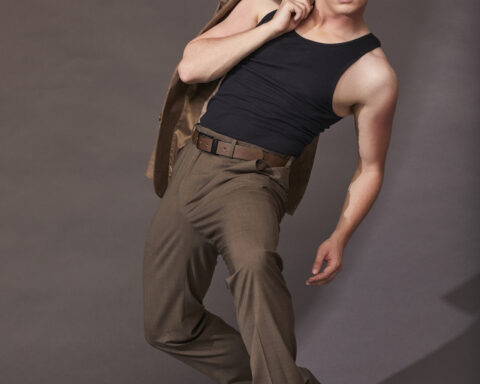Creation is in our nature. There is profound meaning in our existence suggests Sir Daniel Winn’s remarkable art film Creation. The short film presents the idea that each of us has the capacity to create our own reality while we are alive. Through our thoughts and beliefs, we have the power to shape the world around us. You might be fabricating negative or positive narratives in your consciousness, you are still creating. Many religions and other social systems encourage people to accept that life is already planned out and that one’s destiny is beyond one’s control. Sir Daniel metaphorically illustrates that through the power of the mind, life is largely of our own making.
Art Imitates Life
Through his own determination and vision, Sir Daniel has been able to shape his life in a way that is truly remarkable. His expedition of self-expression and personal growth was abundant with hard-won teachings, where the heaviness of his early-life challenges was frequently insurmountable. Deep within, he always felt a guiding presence and knew that he was capable of being the architect of his own life if he continued to forge ahead. Today, he is a prolific contemporary artist, fine art curator and founder of Winn Slavin Fine Art Gallery, one of the most prestigious galleries in the world. As an artist, his work has been showcased alongside the likes of Salvador Dali and Pablo Picasso. He is the Chairman of The Academy of Fine Art Foundation and a celebrated philanthropist. In 2018, he was knighted with the honorary title of ‘Sir’ by Prince Waldemar of Schaumburg-Lippe in recognition of his philanthropic contributions.

Using the medium of film as a canvas, Sir Daniel’s philosophy of Existential Surrealism is brought to life in Creation. The acclaimed artist’s philosophy uses visual language to look at the very nature of our existence; why we are here and what our purpose is. It communicates the inherent dichotomies present in life; between reality and perception and the physical and the spiritual realms. Watching the film provides a unique opportunity for people to gain a deeper understanding of Sir Daniel’s philosophy through their own interpretation, making it more relevant to their experiences, existence and life. As it speaks to you visually, every frame is full of complex hidden symbolism relating to philosophy, religion, science, mathematics and spirituality.
Creation explores the circuitous nature of life, exposing us to the unseen wonders beyond what the eye can see. There have been countless attempts to uncover the meaning of life through film, yet not in this approach, through the analogy of the creator. Sir Daniel’s incredible two thousand pound life-size Quantum Mechanics: Femme and Homme sculptures from his Dark Matter series are semiotically showcased in the film. In order to transcend all languages, the film is without any dialogue. Despite this arduous undertaking, the silent film retains intrigue throughout by adapting an innovative approach that transcends modern storytelling.
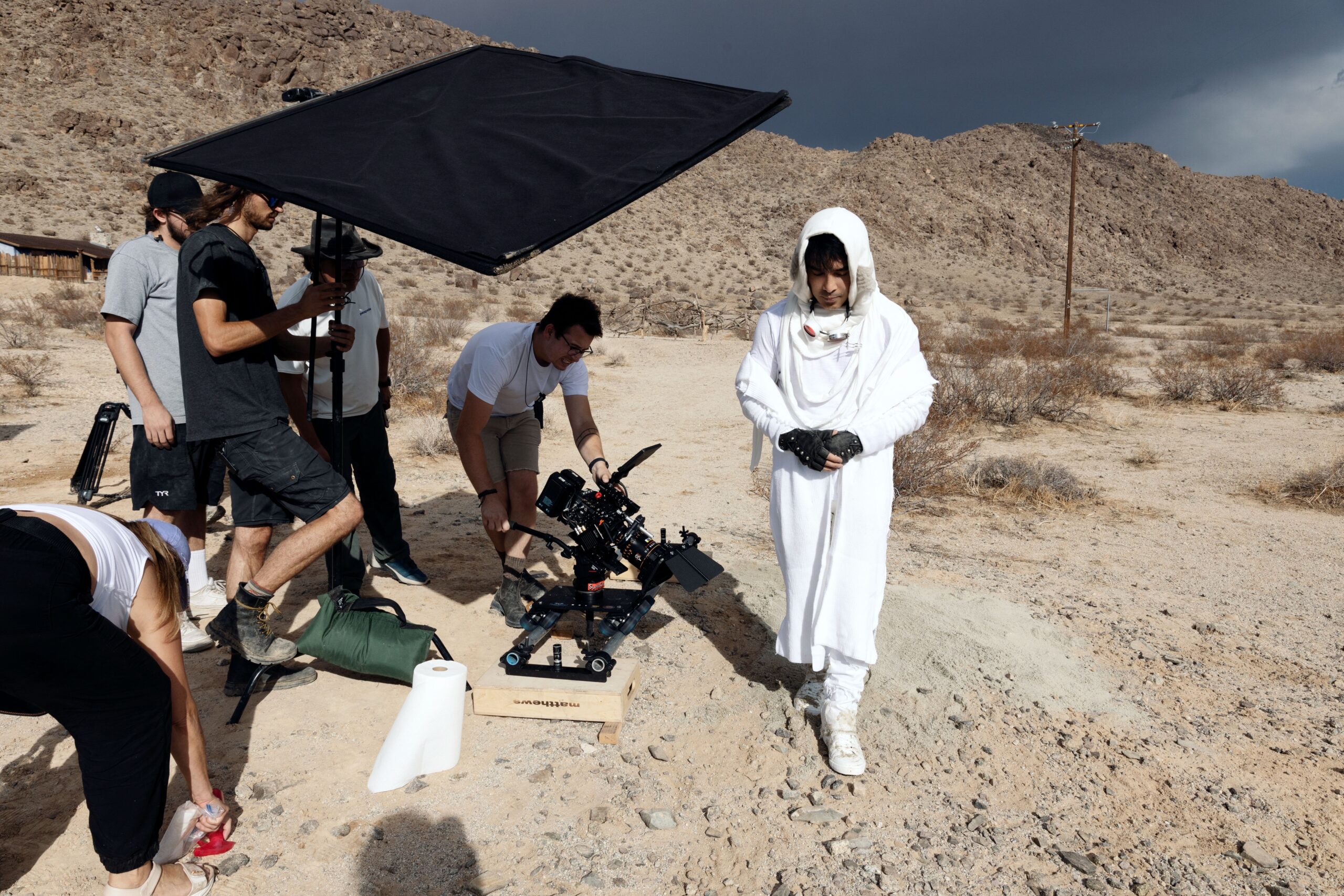
The co-creation between Sir Daniel Winn, executive producer Randall J. Slavin, director Angel E. Vera, cinematographer Jordan Schulz and producer Georges N. Chamchoum have resulted in a thought-provoking film full of deep profound meaning. The natural beauty of Big Sur, Orange County and Joshua Tree provided the perfect backdrop for the film shoot. The filmmakers relied on the resources that mother nature provided, much like the protagonist of the film relies on the elements. Certain natural environments were essential for the authenticity of the film, and they couldn’t be artificially replicated. It was a daunting task, but the most insurmountable challenge was the vagaries of nature, which could derail the filmmaking efforts at any moment. To capture the ideal visual effects for the film, the filmmakers had to meticulously choose the location and weather. The oceanic ambiance of Big Sur exudes a mystical aura that echos the film’s supernatural watchful presence.
The Vision
The silent film catches you from the onset with its black screen and the repetitious sound of a ticking clock, reminding you that time never stops. The sole text and essential message of the eighteen minute film is displayed: “Creation begins where destruction ends…” The simultaneous sound of roaring thunder paired with the ticking clock serves as a dramatic introduction to the protagonist of The Artist (played by Sir Daniel Winn).
His path begins with meditation showing him the way forward through visions. The mind is always creating and instructing, even when you are completely uninspired. A montage of the sky shaking with roaring thunder and foreshadowing flashes of what is to come plays out on the screen. Rendered flashbacks flood into his mind: a sculpture, timepieces, ocean waves and his doppelgänger dressed in black. They are memories of the past, showing that imprints from earlier actions have real substance because they shape what we experience. He sees his alternate, a previous rebirth. This confirms this cycle of reincarnation continues to happen over and over.
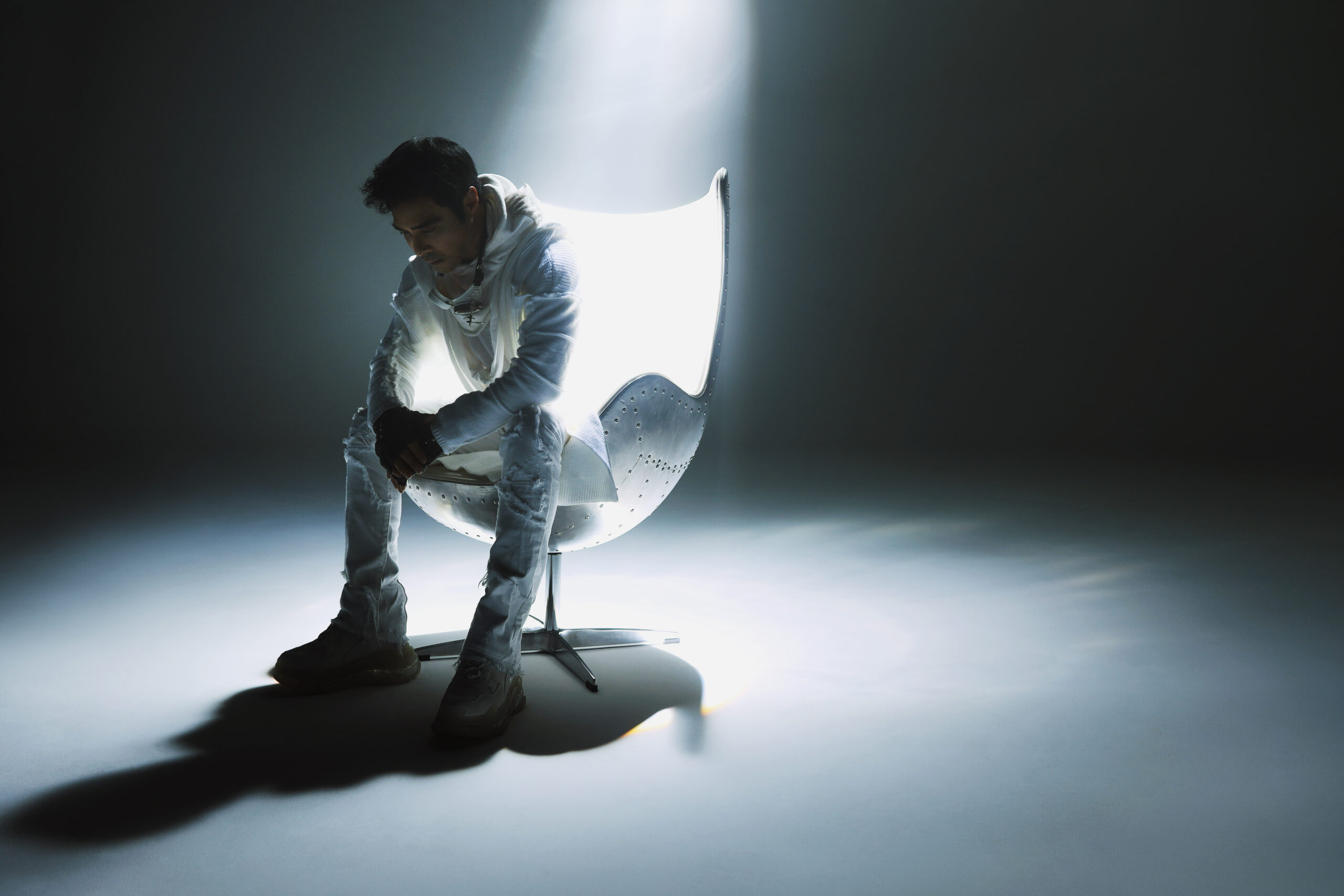
The flashing images at the start of the film are in sharp contrast to The Artist who sits silently in dark isolation, only illuminated by a white light. The darkest hour before the dawn. He is imprisoned in a simulated world created by his consciousness, but there is a way out. A drop of water lands on his face and hand, another dimension is seeping through. Water is present at key moments of The Artist’s transformation throughout the film. Do not be deceived by what you see on the surface, for if you inspect closely you will notice that the chair is shaped like an egg, an emblem of birth and renewal. As he sits in the chair you notice two wings (a recurring symbol) becoming more prominent, signalling his impending metamorphosis.
Taking his inspiration from his visions, The Artist begins his quest. Following the echoing chime of the clock, The Artist enters another realm through a circular portal that can be seen as a past cell of his life. A kaleidoscope of realities from multiple universes intercepting, making us question the concept of reality itself. The symbolism is twofold. The circle embodies the never-ending cycle of life, there is no end to it as it continues into infinity. Secondly, we are reminded of a birth canal where in essence he is symbolically being reborn.
The Elements
The portal delivers The Artist atop a high cliff of rocks surrounded by a cosmic ocean. He looks around. The camera focuses in on his white shoes walking through the water as he arrives at land, ready to explore his new surroundings. The sound of calm waves gently lapping against the shore fills the air. Water plays a major role in the filmmaking of Creation, carrying the cinematic portrayal of a man’s voyage to self-discovery. It’s ever-present and particularly at key moments water influences both the setting and the viewer’s experience with its sights and sounds.
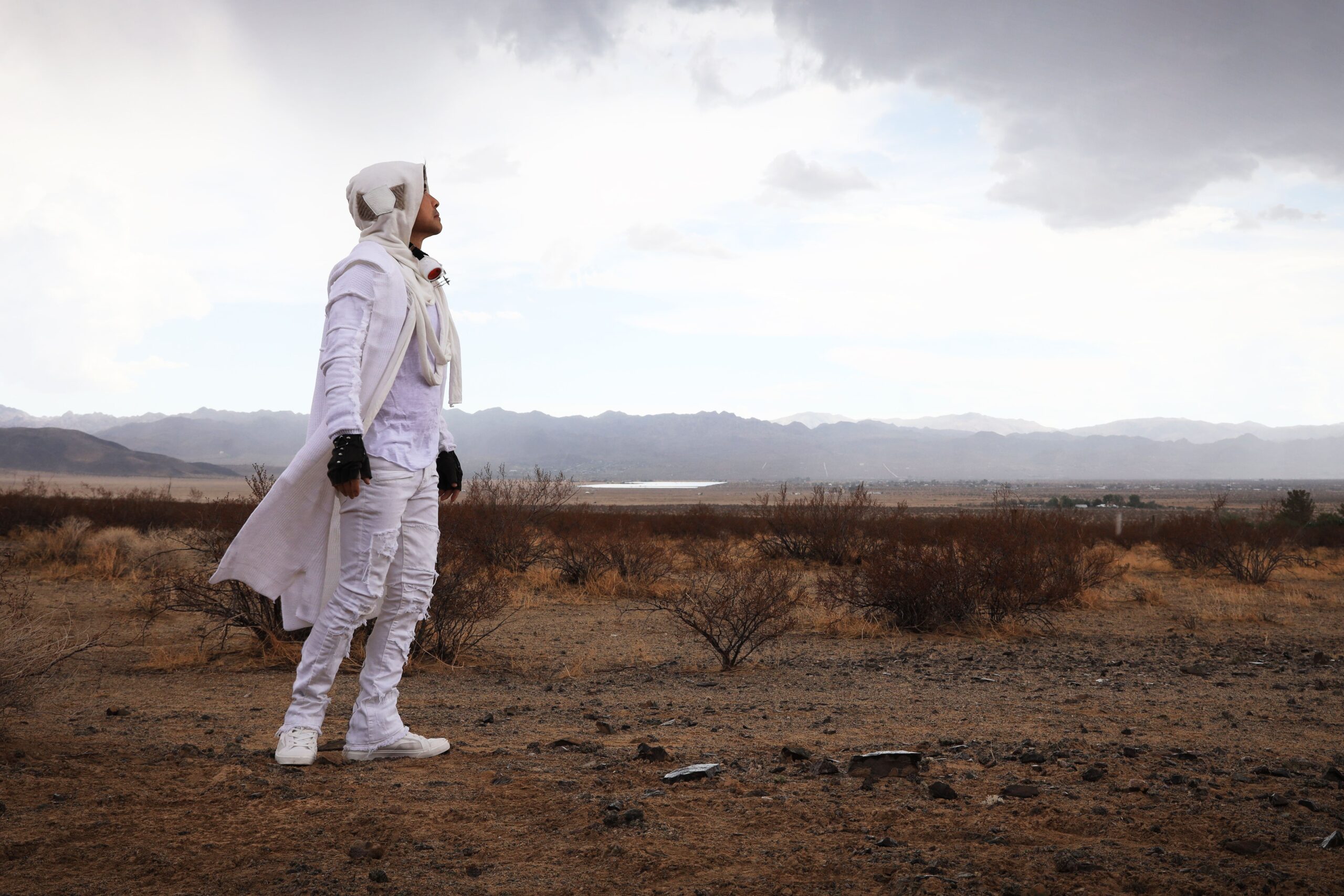
The next few frames show The Artist exploring nature through his senses. He takes in the sights, sounds, aromas and textures of the surrounding land. He lets his fingers pass over the rough surface of the rocky cliff, the moss that has taken hold, and the water flowing down it. He feels the coarse granules of the sand run between his fingertips. He takes in a deep breath of the air, hearing the subtle rustle of the wind around him. A faint rumble of thunder can be heard in the distance, and the first few specks of rain appear. His tools for creation are beginning to reveal themself.
The elements of nature are the core of his creation and critical to understanding the film. Sir Daniel was born in Vietnam and his Asian heritage has greatly influenced his work. For centuries Western cultures believed that air, water, fire and earth were the cornerstones essential for life. The Chinese Philosophy of Taoism consists of five elements: wood, earth, water, fire and metal. Each element is considered superior to the previous one. Taoist philosophy looks at the elements in terms of energy as opposed to matter. The five Taoist elements are metaphors for the patterns of nature, the cosmos, the integration of the human body, the mind and spirit. These philosophical ideas are clearly reflected in Creation, as the elements create life through their energy. According to Taoism, believers must be mindful of the energy of the universe in order to live harmoniously with the natural world and its rhythms.
It is the combination of the elements that enable The Artist’s creation. The elements nurture him, almost forming him as they become ingrained in every fibre of his being. The droplets of water that dance on his face, the caress of the wind, the ground he touches and the salty scent of the air he inhales are natural elements that become apart of him. Hence, the whole concept of the film is that the elements create this individual.
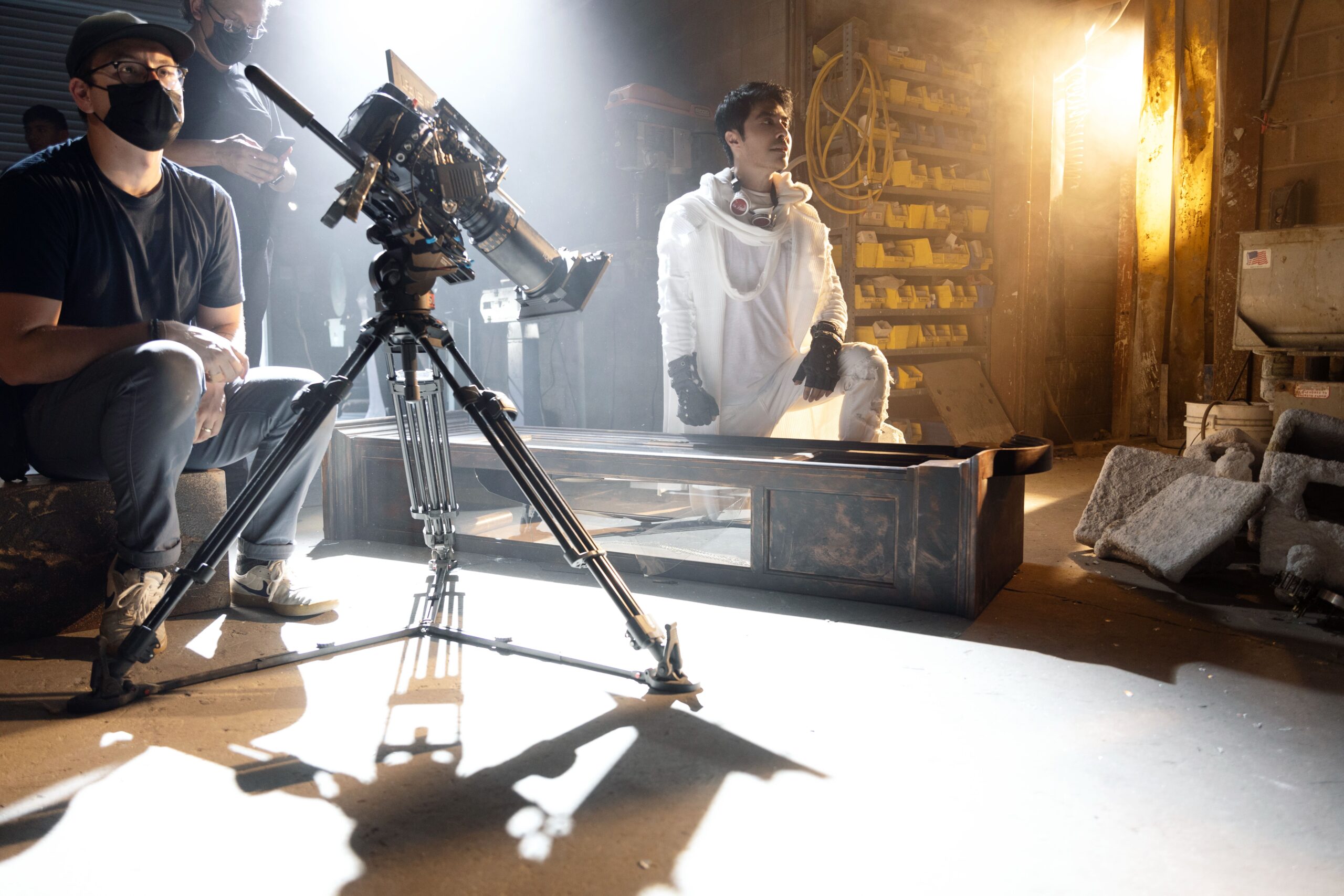
Time
The elements of nature have now begun to nurture The Artist and have led him to a hidden cave. As he enters the cave he hears the familiar sound of the pendulum, signalling it is time. He sees a Grandfather and Grandmother clock, reflecting the duality of masculinity and femininity. He hears the source of the sound he had traversed through galaxies, centuries, parallel worlds and lifetimes to find. He carefully places the palms of his hands on the carved face of the timekeepers and presses his ear against the side of the clock. He closes his eyes and listens. The Artist understands that destruction is a necessary precursor to creation and that in order to create he must first destroy the notion of time. The elements of nature can be destructive and restorative, continuously creating something new.
Time is not linear as we perceive it to be; it’s continuous. There are an endless amount of possibilities for different timelines and alternate pasts, presents and futures. Time is a fundamental motif in the film. The concept of time is an intriguing one. It was impossible to observe the passing of time until the movie camera came into existence, which enabled us to view time in a different manner.
Due to having no dialogue in the film it is imperative every emotion is shown through Sir Daniel’s performance. The momentum builds as tears roll down his cheeks as he stares at the timekeepers. Life changes as do hands on a clock, amplified with time. The clock’s hour and minute hands racing around their numbered, circular prison. The symbolism is rich as the face of the clocks are in a circle representing that time is infinite. The metallic sound shakes the world around him, as they figuratively speak to him. You get a sense that he can hear their metaphorical words whispered in his ear, “I wish for a new life.”
He knows what he must do. He pushes the clocks down, shattering them completely. The destruction left in their wake will be the foundation for something new. With a gentle touch, he carefully picks up the two hearts of the timekeepers, the cold metal still ticking away in perfect harmony. They are still working. He is in tune with himself and the rhythm of nature, no longer beholden to the clocks for direction or guidance. The Artist has discovered his true identity. He knows who he is now. He understands he is now The Sculptor.

Resurrection
As we watch him carefully removing the core of the clock, the intricate mechanisms that powers its workings, we are reminded of life’s continuous journey. He can start building his own creation through the ruin of what was previously there. The next scene reveals The Artist in his element, creating with a focused intensity. The cave is filled with the remains of its past purpose. Tools, machinery and a fire kiln give him a sense of connection to the artists who had been there before him. He has also been here before, time after time across the span of innumerable lifetimes. He feels compelled to create. This may also indicate that he had visualized this artistic sanctuary and brought it into reality.
Each step of his sculpting process emphasizes the idea of creation and destruction. He began by forming the sculptures from dirt and water to make clay, carefully molding the material over a metal structure to form the sculptures. Then the clay was destroyed as a thick liquid was poured over it to form the master mold. The Artist fills a master mold with a clear liquid and places the ticking heart into the mold, symbolizing the life that will be born. He is now molding fractured time, mixing the past with the present and the future. Metaphorically shaping his perception of reality like clay.

In the next sequence, we see him forming the base, wings, masks and headgear from the same mold. These iconographical symbols have come to him throughout the film through his visions representing the five elements as winged creatures. He melts a solid bronze stainless steel metal with fire and pours it into the shell. He is bringing in the elements (wood, earth, water, fire and metal) to his creation, yet at the same time the shell must be destroyed for them to emerge. The idea of creation beginning where destruction ends is continually reinforced throughout the film and the underlying theme.
The Artist slumps to the floor, drained of energy, limbs heavy with fatigue. He has poured his heart and soul into these masterworks, sacrificing time and effort. His once-pristine white garments are now soiled, covered in dirt and clay from the aftermath of creation. He baptismally splashes his face with water, marking a spiritual rebirth. In the following scene, The Artist appears in black garments, mirroring the vision he had at the start of the film. After the statues have been biblically raised, The Artist stands back in awe and takes a moment to marvel at the grandeur of his opus. The choir music adds to the surreal atmosphere, creating a celestial moment in the film.
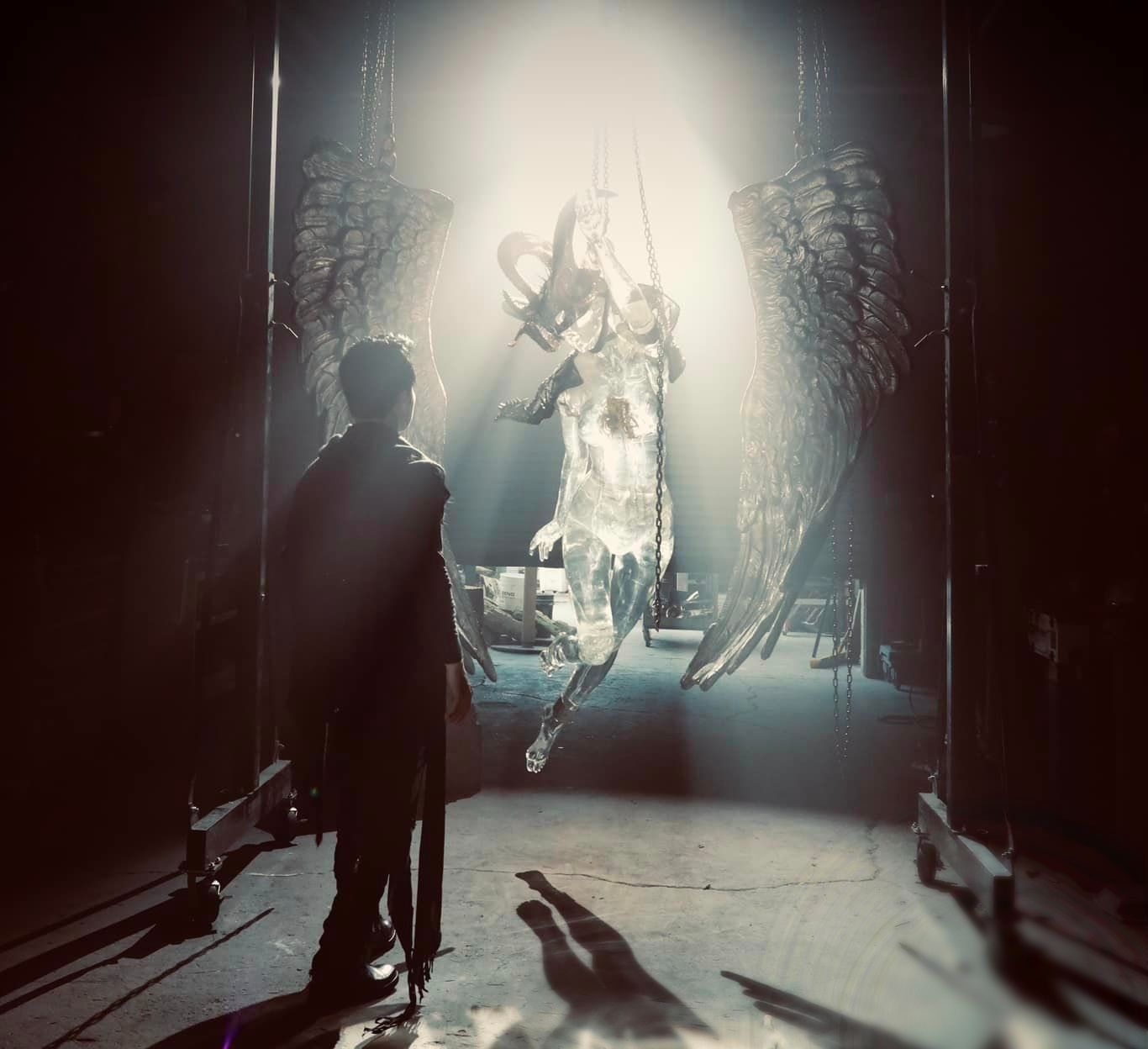
The Gift Of Life
The audience is brought back to the ocean and terrain for the final act of the film. There they stand, the intricately crafted Femme and Homme isolated on their own. Their see-through lucite bodies glisten under the light as their wings and masks shimmer. The wings signify independence, the mask evokes the disguise we veil ourselves with and the horns on the headgear denote immortality. Perhaps if we show who we are, we will have the freedom to continue forever in some form or another.
As with all journeys, he must go back to where it all began. The film commenced amidst darkness and culminates as he enters the light, symbolizing a new phase of life. Before returning to the portal, The Artist connects with his creations one last time. One final glance, you can feel the electricity between The Artist and the lifelike figures. He touches each of their delicately carved hands, human flesh connecting with inanimate material. It is now time for him to take his journey alone and make his way over the rocks towards the coastal setting, leaving his creations behind. With satisfaction in every vein of his body he crosses the picturesque landscape, heading for the ocean. The sun’s rays shine through the clouds, a constant reminder of the same light that has been with him since the start of the film, signifying that there is always something guiding you from within.
The Frankenstein moment of the film is when the camera focuses on the transformation of a foot from lucite to human flesh, showing life has begun. The metal wings, masks and headgear fall into the sand. Only once the elements connect with the sculptures through a spark of lightning (another force of nature that cannot be controlled) do they come to life. The brief flashes of electrical current in the sky hints at an impending message in the film; transitory events are here and gone in a flash. From the destruction of the sculptures is when the organic human bodies walk off into the distance. A Black man and a White woman; his Adam and Eve.
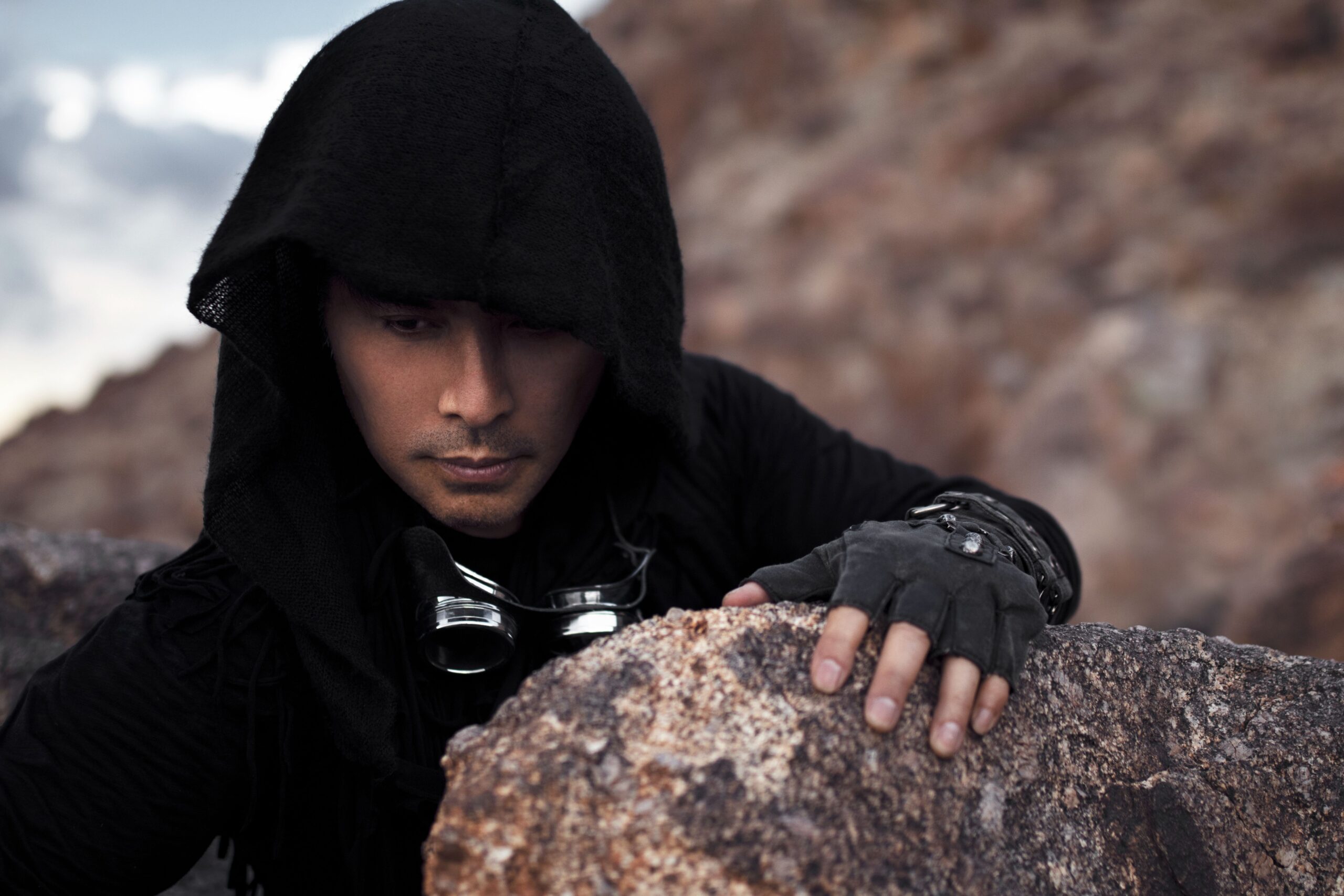
Existential Surrealism
With each decision The Artist has made, he was carving his reality into works of art. Two sculptures poetically illustrating the symbol of humanity and the exceptional power of our life form. He has turned substance into form using the elements. He has produced something remarkable and extraordinary, serving as a metaphor for the innate ability for creation that is present in each of us. Our hands enable us to create, our minds to conceptualize that which has yet to exist, and our languages are powerful enough to convey and comprehend abstract concepts. As life forms we have the ability to write, speak, invent, paint, sculpt… create.
Dualism is an inherent part of human existence. The film and Sir Daniel’s philosophy explores the duality between light and dark, life and death, black and white, yin and yang, sun and moon, hot and cold, arid and lush, organic and inorganic, masculine and feminine. The dichotomies of these opposing factors suggest that one without the other would have no significance and can help us in trying to understand life and ourselves. The idea of the Chinese philosophy of Yin and Yang is how balance and oppositional forces within nature complement one another. It defines unity and expresses that we are one — no matter our faith, our sex, our language or our color.
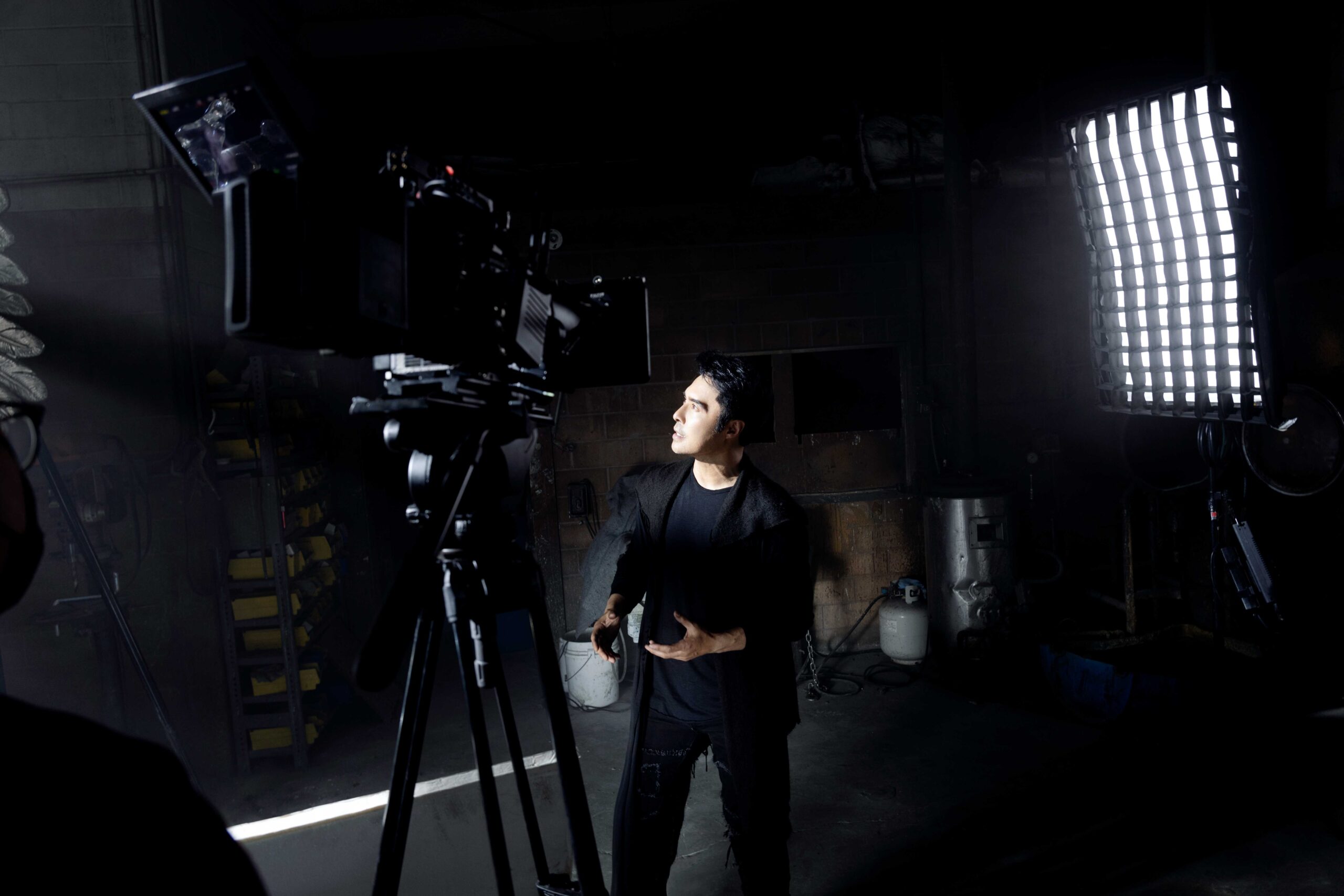
Creation masterfully unveils the answer to the philosophical enigma of universal truth is our shared connection to the elements. Femme and Homme were made from wood, earth, water, fire and metal. The elements created The Artist, he built the sculptures and they depended on the elements for life. So in essence, we are the elements. We are all part of the elements, they are part of the earth, which is part of the galaxy, which is part of the universe. We are all made of one and made equal. All the elements in the universe make us one humanity. The elements are constantly creating us in a special and infinite way. We in turn, have the potential to create our lives. It is naturally part of our being to be creative. We are each exceptional individuals. The film emphasizes that we each can manifest our own innate creativity during our lifetimes, just as Sir Daniel has exemplified. Embrace the power within to create, use it to fulfill your purpose and make a positive influence that will leave a legacy that resonates far beyond your own life.
Creation has garnered critical acclaim and recognition, winning prestigious awards such as the Best Long Format Short Film at the Experimental Dance & Music Film Festival, the Best Short Film at the Montreal Film Festival and Best Cinematography at the Venice Short Film Festival. A masterpiece of this caliber calls for a particular standard of precision and complexity that cannot be contained within an 18-minute short film. Sir Daniel Winn’s creative team including award-winning director & cinematographer Jordan Schulz and writer Andrew Creme will continue to take on life’s biggest questions in the ninety-minute upcoming feature film.




